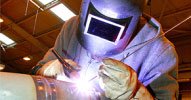Material Grade
AISI 410/ALLOY 410/SS 410
Alloy 410 is a hardenable,straight-chromium stainless steel which combines the superiors wear resistance of high carbon alloys with excellent corrosion resistance of chromium stainless steels.Oil quenching this alloy 410 from temperature between 1800° F to 1950°F(982-1066°C) produces the highest strength and wear resistance. A range of as-quenched hardness is achieved by varying the carbon level from . 15% Maximum in Alloy 410 This alloy is used where strength ,hardness,and wear resistance must be combined with corrosion resistance.
Fabricating Properties Machining?Alloy 410 should be machined in the annealed condition using surface speeds of 60 to 80 feet (18.3-24.4 m) per minute.
Surface Preparation?For maximum corrosion resistance to chemical environments, it is essential that the stainless steel surface be free of all heat tint or oxide formed during forging, annealing, or heat treating. All surfaces must be ground or polished to remove any traces of oxide and surface decarburization. The parts should then be immersed in a warm solution of 10-20% nitric acid to remove any residual iron. A thorough water rinse should follow the nitric acid treatment.
Structure in the annealed condition, Alloy 410 consists of ferrite and carbides. When this alloy is heat treated at high temperatures [1800°F-1950°F (982-1066°C)], austenite will form and transform to martensite upon cooling to room temperature (i.e., air cool or oil quench). The hardness of the martensite will increase with increasing carbon content to a point where the martensite becomes saturated with carbon. Carbon also combines with carbide formers such as chromium to form chromium carbides which are dispersed throughout the microstructure to provide added wear resistance, as does higher hardness.
Heat Treating To anneal this alloy, heat to 1500°F-1550°F (815-842°C) and hold for one hour per inch of thickness and furnace cool to room temperature. Such annealing should produce a Brinell hardness of 126-192 HB in Alloy 410 material.
A hardening heat treatment is necessary to bring out the maximum hardness and wear resistance. Since these materials absorb heat very slowly, they should be heated gradually and allowed to remain at temperature long enough to ensure uniform temperature in thick sections. For maximum strength, hardness, and corrosion resistance, slowly heat the alloy to 1800°F (982°C) and quench to room temperature in oil.
Specifications
| Standard | AISI 410 |
| UNS | S 41000 |
| Werkstoff Nr. | 1.4006 |
Mechanical & Physical Properties
| Density | 8.03 g/cm3 |
| Melting Point | 1440 °C (2552 °F) |
| Tensile Strength | Psi-74000 Min MPa-510 Min |
| Yield Strength (0.2%Offset) | Psi-42000 Min MPa-290 MIn |
| Elongation | 34 Min |
Chemical Composition
| AISI 410 | |
| Ni | 0.5 Max |
| Fe | BALANCE |
| C | 0.15 Max |
| Mn | 1.00 Max |
| Si | 1.00 Max |
| Cr | 11.5-13.5 |
| Mo | -- |
| p | 0.04 Max |
| S | 0.03 Max |
Application

Chemical Industry

Food Processing

Aircraft Industry

Fabrication Industry

Soap Industry



















